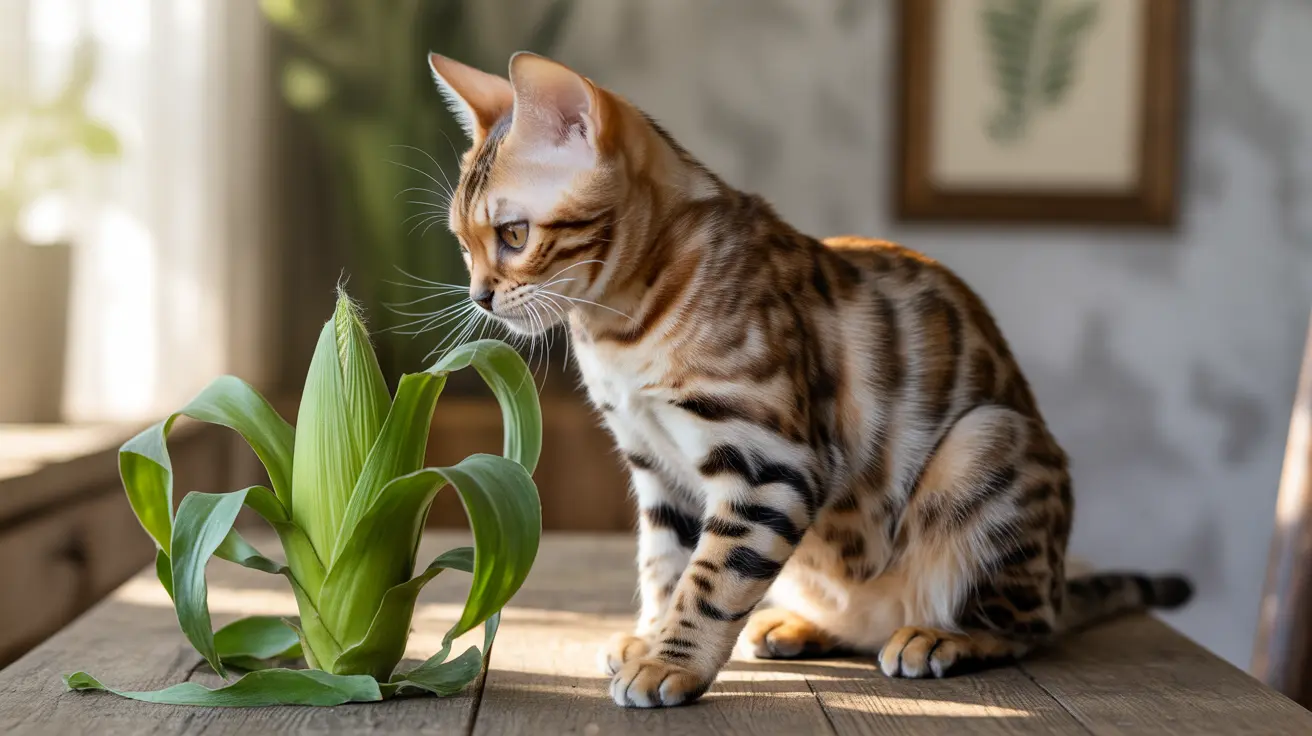Introduction
Understanding the dangers of common houseplants is crucial for cat owners, and the corn plant (Dracaena fragrans) poses a significant risk to feline companions. While these popular decorative plants add a tropical touch to indoor spaces, they contain toxic compounds that can cause serious health issues in cats. This comprehensive guide explores the risks associated with corn plant toxicity in cats, helping you recognize symptoms, understand prevention strategies, and know when to seek veterinary care.
Understanding Corn Plants and Their Toxicity
Corn plants, members of the Dracaena genus, contain steroidal saponins throughout their structure. These compounds are particularly concentrated in the leaves and stems, making every part of the plant potentially dangerous to cats. Despite their misleading name, these plants are not related to actual corn but are tropical houseplants known for their long, striped leaves.
The plant's toxic components can cause immediate cellular damage when ingested, leading to various concerning symptoms. Even small amounts can trigger adverse reactions in cats, whose smaller body size makes them especially vulnerable to plant toxins.
Recognizing Symptoms of Corn Plant Poisoning
Immediate Signs
When a cat ingests parts of a corn plant, symptoms typically develop within a few hours. Common early signs include:
- Excessive drooling
- Vomiting (sometimes with blood)
- Diarrhea
- Loss of appetite
Advanced Symptoms
As the toxins take effect, cats may display more serious symptoms:
- Weakness and lethargy
- Uncoordinated movement
- Dilated pupils
- Increased heart rate
- Depression
Treatment and Emergency Response
If you suspect your cat has ingested any part of a corn plant, immediate veterinary attention is crucial. The veterinarian will likely:
- Perform a physical examination
- Induce vomiting if the ingestion was recent
- Provide supportive care including IV fluids
- Monitor vital signs
- Administer medications to control symptoms
Prevention Strategies
The best approach to protecting your cat from corn plant toxicity is prevention. Consider these essential steps:
- Remove all corn plants from your home
- Research pet-safe alternatives for indoor greenery
- Create designated plant-free zones for your cat
- Provide cat-safe alternatives like cat grass or catnip
- Use deterrent sprays on any plants in transitional areas
Safe Plant Alternatives
Several attractive houseplants are safe for homes with cats:
- Spider plants
- Boston ferns
- African violets
- Swedish ivy
- Bamboo palm
Frequently Asked Questions
Is the corn plant toxic to cats, and what are the symptoms of poisoning?
Yes, corn plants are toxic to cats due to steroidal saponins. Symptoms include vomiting, diarrhea, excessive drooling, lethargy, and uncoordinated movement. In severe cases, cats may experience increased heart rate and breathing difficulties.
How can I prevent my cat from eating corn plants, and what are some safe alternatives?
Remove corn plants from your home entirely or place them in completely inaccessible areas. Consider pet-safe alternatives like spider plants or Boston ferns, and provide cats with their own safe greenery like cat grass or catnip.
What should I do if my cat ingests a corn plant, and when should I seek veterinary help?
Seek immediate veterinary care if you suspect your cat has ingested any part of a corn plant. Quick intervention is crucial for the best outcome. Contact your veterinarian or emergency animal hospital right away.
Are all parts of the corn plant equally toxic to cats, or are some parts safer than others?
All parts of the corn plant contain toxic compounds, with the highest concentration in leaves and stems. No part of the plant should be considered safe for cats to consume.
How can I ensure my home is cat-safe from toxic plants like corn plants?
Regularly audit your houseplants against the ASPCA's toxic plants list, remove dangerous plants, create pet-safe zones, and provide appropriate alternatives for cats who like to chew on plants.
Conclusion
While corn plants are attractive houseplants, their toxicity makes them incompatible with cat ownership. The risk to feline health far outweighs any aesthetic benefits. By choosing pet-safe alternatives and maintaining vigilance about potentially toxic plants, you can create a beautiful and safe environment for your feline companion.






